Snakebite Symptoms
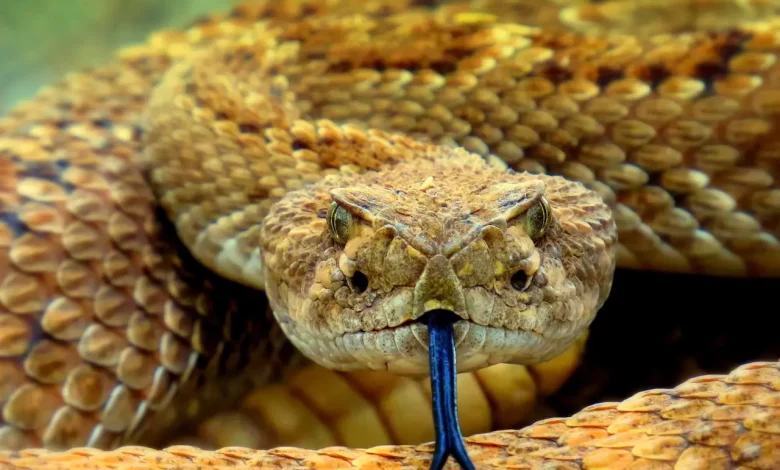
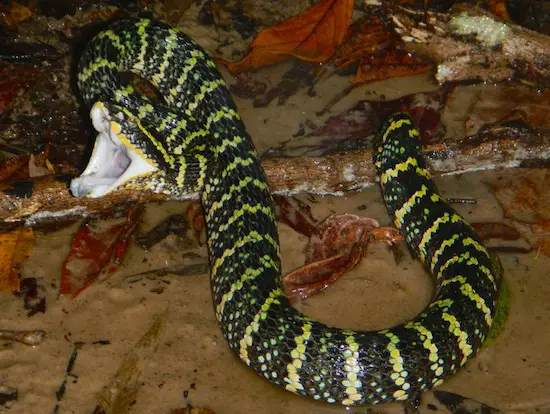
Over 125,000 people die as a result of snakebite across the globe yearly. Snakebite symptoms vary with the type of snake and the severity of the bite and whether envenomation (venom injected) takes place, or not.
Some bites cause severe and painful symptoms. Other snake bites cause nearly no symptoms at all. Below we cover a large variety of snakebite symptoms from swelling to paralysis, so you can assess whether you were envenomated during a bite.
Sometimes people are not sure they were bitten by a snake. You should be able to decide after reading the information below.
If you KNOW you’ve been bitten by a snake – here is WHAT TO DO >
Snake Venom
Produced in venom glands, snake venom moves from the gland to the fang through a duct (tube). During a bite in which the snake wants to use some venom, the gland is compressed by muscles around it. Some snakebites are without venom – dry bites.
In defense, some snakes bite ‘dry’ 70% of the time or more. Others use venom most of the time. Even if bitten by a snake, it is not at all certain the victim will be envenomated.
What Does a Snakebite Look Like?
Bites from snakes can resemble bites from other animals. Typically, bites from a venomous snake will include 1 or 2 distinct puncture marks on the skin. These puncture holes may be only 2-3 mm apart (1/8th inch) in the case of a small coral snake, or they could be as much as 8 cm (3.1 inches) or more with a large king cobra.
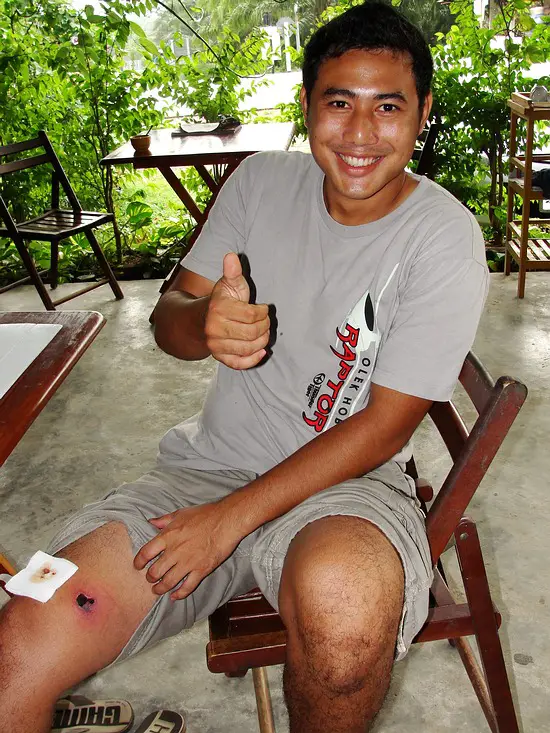
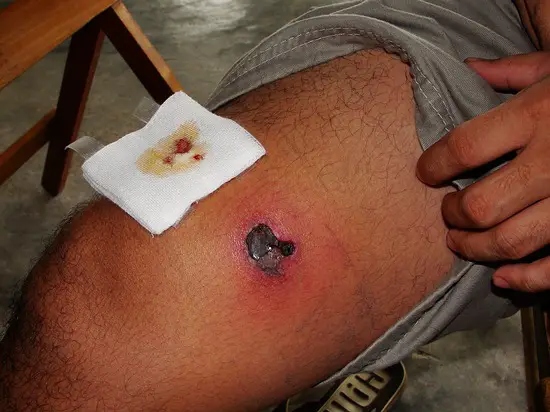
When you look closely at the bite site, you may be able to see other very small punctures or scrapes from snake teeth on the skin. This can help you rule out a centipede or spider bite which only have 1-2 puncture wounds unless they bit multiple times.
In the image above right you can see the fang marks blended together where the necroses destroyed tissue between them. Monocled Cobras have neurotoxic and necrotic venom.
Below I’ve recreated some typical venomous snakebites with a red pen.
Venomous Snakebite Fang (and other teeth) Marks




Are Fang Marks Always Visible?
Keep in mind, there is not ALWAYS a visible mark from a snakebite. Fangs can be of ultra-small diameter. Look at the post where we examine a juvenile king cobra’s fangs. These fangs were considerably smaller than the diameter of a needle!
All venomous snakes can have very thin fangs that may not leave obvious puncture wounds. In fact, herpetologist Joseph Slowinski, after bitten by a juvenile many-banded krait (Bungarus multicinctus), observed no puncture wounds at all.
Within 2 days, he was dead of envenomation from the bite. He wasn’t able to make it to the hospital in Myanmar for a number of reasons, had he received medical care, he would likely still be alive. Don’t delay treatment!
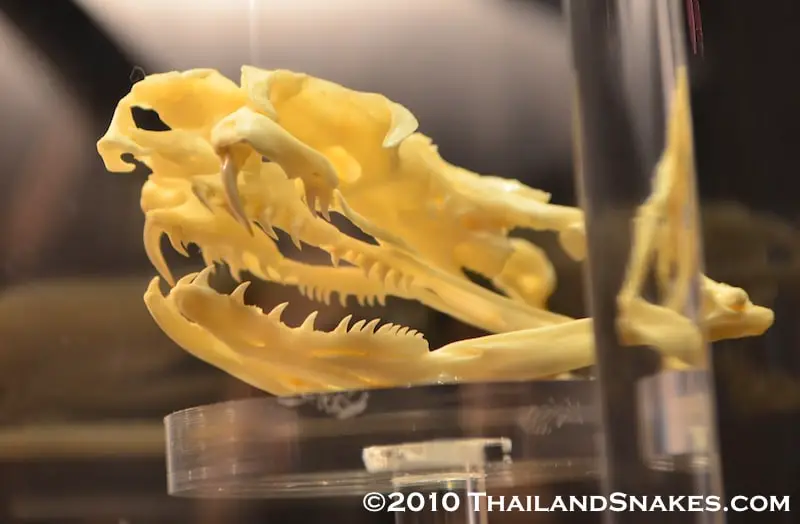
Some people are bitten at night as they sleep. This is a too-common experience in rural areas of Southeast Asia where people think nothing of sleeping on a road, their porch, or inside their house with the door open.
They roll over on a krait or cobra, are bitten, and don’t feel anything strong enough to wake them up. By morning, they are incapacitated, sometimes suffering complete paralysis from the strong venom. Doctors may or may not find fang marks, so a diagnosis of the problem can take longer.
Do All Venomous Snakes have Front Fangs?
No. Here in Thailand, we have some snakes that are rear-fanged. For some examples, Rhabdophis subminiatus (red-necked keelback) and some of the cat snakes (Boiga genus) are not front-fanged.
In all cases, the symptom list below should be your guide as to whether or not you go immediately to the hospital after a bite.
Some biologists say that all snakes have some venom components, so if you experience any severe symptoms after a bite, do the right thing and get to the hospital quickly.
Life-Threatening Snakebite Symptoms
If you experience any of the symptoms below after a snake bite or suspected snake bite, (or any animal bite), have someone immediately transport you to the emergency room at the nearest large hospital.
Avoid small clinics if possible, they may not have the experience, and almost surely won’t have the proper antivenin for snakebite treatment, not to mention life-saving equipment like breathing apparatus.
- moderate to extreme pain at the bite site – probably indicative of viper or cobra bite
- blistering, swelling, necrosis (dying tissue) at the bite site (skin and tissue/blood under skin turning black)
- trouble breathing, tightening of the throat, rapid or slow breathing (any breathing change)
- itchiness of throat
- abdominal pain or odd feeling as if ready to throw up (nausea), or actively throwing up
- numbness in muscles, especially eyelids – inability to hold eyelids open
- rapid heartbeat, irregular heartbeat
- sweating
- blood from nose, gums, rectum, ears, eyes, etc.
- diarrhea
- dizziness or collapse
- convulsions
Non-Emergency Snakebite Symptoms
The following list of symptoms is generally associated with a snakebite that isn’t life-threatening, and not very dangerous. However, if you have a combination of these symptoms or your symptoms change for the worse, or if you have ANY symptom in the Life-Threatening Snakebite Symptoms list above, have someone take you to the hospital immediately.
- puncture marks on skin
- some red/pink discoloration around the bite site
- no red/pink discoloration at all
- slight or no pain at the bite site (can still be elapid bite)
- very little or no swelling at the bite site or on the bitten limb (can still be elapid bite)
- itchiness at the bite site or other places on the body – can be warning of impending allergic reaction, keep close eye on symptoms.
- slight amount of blood from puncture marks is normal
Elapid and Viper Snakebites
Elapids like cobras, kraits, and coral snakes have two enlarged fangs in the front of the mouth which are specialized for injecting venom subdermally. Venom travels through the lymph node network and blood vessels to quickly spread throughout the body. With Elapid bites, you should wrap the bite like the video below shows.
Pit vipers have a different kind of venom that primarily destroys the tissue and causes blood clotting to such a degree that eventually all the clotting factors are used and the snakebite victim can bleed from orifices with little or no clotting ability.
In case of a bite by a viper, no wrapping or touching of the bite site is recommended, just get to the hospital promptly and you’ll likely recover fine. Some vipers with very long fangs can inject so deep they can reach muscle tissue.
These are generally more complicated bites than a bite in which the skin is scraped or barely punctured.
Pit viper fang marks can be a bit different than bites from the elapids because the fangs generally have a thicker diameter and can cause more bleeding. It is also more likely that a person will recognize being bitten by a viper as the pain from the venom destroying tissue immediately upon contact can be quite severe.
How Common is Venomous Snakebite?
In the USA, Canada, European countries, and cooler places on Earth, there are very few venomous snakebites.
When someone is bitten in a first-world country, a quick visit to the hospital emergency room virtually guarantees the person will survive after a venomous snakebite.
The problem is in less-developed countries where the medical personnel and technology are not up to speed, or the snakebite victim delays treatment at the hospital.
India has an extraordinarily high rate of snakebite and deaths from snake bites. In Thailand we probably have a hundred or a couple hundred people die each year from snakebite, but even that high number is primarily because there is an unwillingness to go to the hospital because of cost of treatment, especially for low-income people.
Instead, they treat snakebite with herbal ‘remedies’ which further complicates their recovery. In many cases, they visit the hospital too late to fully recover.
How Can You Prevent Snakebite?
The biggest cause of snakebite is when someone is trying to kill, handle, or otherwise interact with a snake that just wants to be left alone. Avoid this, and you’ll be ahead of the pack.
Otherwise, using a headlamp at night when walking in grass, on dirt, on a sidewalk, or literally anywhere at night, will help you to see venomous snakes which are nocturnal (active at night).
Venomous Snakebite Stories Book
If you haven’t yet, get your copy of our “Venomous Snakebites and Near Misses” book. I’ve written about some of my own mishaps and those of others who I know. Included are stories about banded kraits, king cobras, monocled cobras, vipers, and coral snakes. I know you’ll enjoy it!

Snakebite Resources
- The University of Adelaide Australia’s “Toxinology.com.”
- World Health Organization “Snakebite.”
- Snakebite from Science to Society (PDF). World Health Organization.
